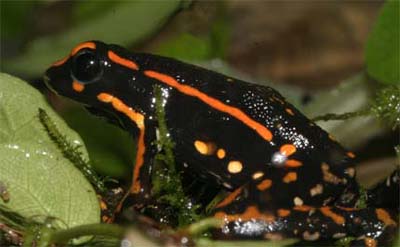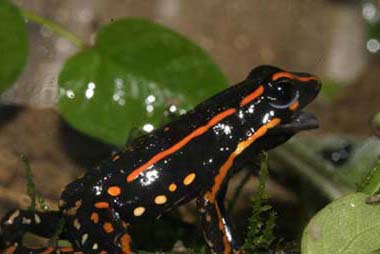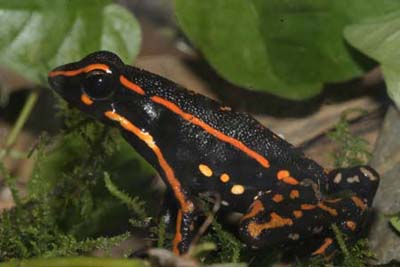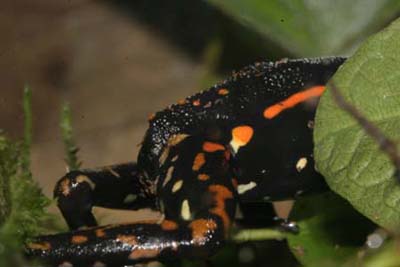  |
Epipedobates trivittatus is a great frog (I say that a lot), but they are
really not for beginners. In the wild they are found in areas of Peru and
Suriname.
Many of the trivs that you see in the hobby are WC animals. E. trivittatus are
not actually hard to care for, but they have some very specific
breeding requirements and that seems to keep their numbers
low in the hobby. They are a big, active dart frog--females can be up to
60 mm with the males a bit smaller than the females. They can really
jump and when startled, may launch themselves into the sides of the
vivarium. For this reason, we recommend background materials on 3 sides of
the enclosure so they feel more secure and to prevent injury. We also recommend providing plenty of
hiding places, although with time these frogs will become quite bold. The males
have a pleasant audible breeding call, and also have a series of other vocalizations.
The frogs from Suriname come in several different color morphs: red- striped,
orange-striped, yellow-striped and green-striped. We have the red-striped
morph. As you can see from the pictures above the skin on their back and
upper
legs is quite granular and is a distinguishing characteristic. I have included a picture of the pattern on the
backs of the thighs too.
Eggs and breeding : This is where the difficulty lies in E. trivittatus husbandry. Much of the information related here is based on our research and not personal experience; our pair is newly acquired and are still being acclimated to their environment. Trivs need a large heavily planted vivarium in order to induce breeding. In the wild these frogs are not usually found in large concentrations and are most often found in the thickest vegetation and rarely in the open. These frogs are also found by streams during the breeding season so a moving water feature in a vivarium is desirable. Male/male and female/female aggression has been reported. We have set up our vivarium with a small stream and pool for the water feature. |
This water feature is powered by an external canister filter that biologically cleans the water and the return generates the stream. We also use the substrate foundation, a mixture of LECA, gravel and sand (cleaned gravel and play sand is used for the "pond" bottom ) as part of the filtration system. The enclosure has a lot plants, including some of the larger bromeliads. We also set up the enclosure with an upper tier to offer maximum floor space. Males call readily even when conditions are not optimal for breeding, but the females need the right conditions in order to select egg laying sites. We provide multiple sites in the form of coco huts over petri dishes, flower pots, petri dishes under a leaf litter bower and even pill bottles hidden in the leaf litter. Breeding behavior is reported to be similar to other species. Given the number of potential egg deposition sites we have placed several oak leaves in the pond because we realize that we may not find the eggs (if any are laid) before they hatch out. This way the male can deposit the tads in the water feature and we will rear them (or at least some of them ) there. Trivs lay a lot of eggs and clutches as high as 30 are not uncommon. Tads are omnivorous can be raised communally and will be fed our tadpole mix. Metamorphosis takes around 60 days. Froglets morph out very small for such a large frog and it is recommended that a large supply of springtails is kept on hand for the first couple of weeks they can be switched over to fruit flies. |
 |
 |
Based on our research, the trivs like a large, well planted
vivarium with a water feature. We have provided multiple egg laying sites
for these frogs.
We keep the humidity high with regular misting and do not let the
temperature rise above 83.
Note:
Ephipedobates in general seems to like lower temperatures than some of our
other species.
Summation:
Size- 45- 60 mm, visual differences between sexes are not apparent other than females are larger and rounder, males have a variety of vocalizations and a loud calll
Care- WC animals are very shy and flighty. Exercise caution and slow
movements in front of the vivarium until the animals get used to you. With
proper care and attention, they will become quite bold
Food- Trivs are aggressive feeders and even the shyest trivs will come out
into the open to feed. Because of their large size they will eat a variety
of food items and can easily handle most of the food available to dart frog
owners.
Eggs and Tads- based on our research, not personal experience) Trivs lay
many eggs, tads are omnivorous and can be raised communally
Temperature- 70°-80° In the spring and fall we let the temperatures fall into the low 60's
Locality - Peru and Suriname
|
|
|

